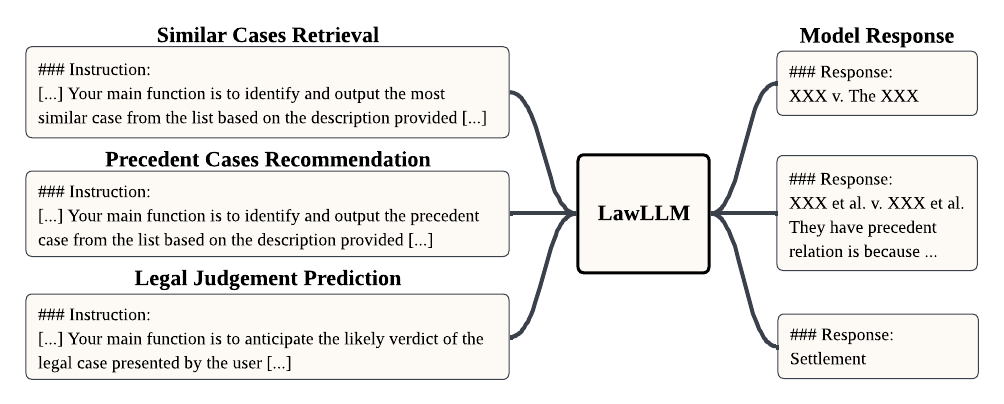In the rapidly evolving field of legal analytics, finding relevant cases and accurately predicting judicial outcomes are challenging because of the complexity of legal language, which often includes specialized terminology, complex syntax, and historical context. Moreover, the subtle distinctions between similar and precedent cases require a deep understanding of legal knowledge. Researchers often conflate these concepts, making it difficult to develop specialized techniques to effectively address these nuanced tasks. In this paper, we introduce the Law Large Language Model (LawLLM), a multi-task model specifically designed for the US legal domain to address these challenges. LawLLM excels at Similar Case Retrieval (SCR), Precedent Case Recommendation (PCR), and Legal Judgment Prediction (LJP). By clearly distinguishing between precedent and similar cases, we provide essential clarity, guiding future research in developing specialized strategies for these tasks. We propose customized data preprocessing techniques for each task that transform raw legal data into a trainable format. Furthermore, we also use techniques such as in-context learning (ICL) and advanced information retrieval methods in LawLLM. The evaluation results demonstrate that LawLLM consistently outperforms existing baselines in both zero-shot and few-shot scenarios, offering unparalleled multi-task capabilities and filling critical gaps in the legal domain.
visit this link and request the access to the Gemma-7B model.
Once request is approved, use the same email adrress to get the access of the model from HF here.
Once both requests are approved, follow the below directions.
git clone https://github.com/Tizzzzy/Law_LLM.git
cd Law_LLM
pip install git+https://github.com/huggingface/transformers
# python 3.10 or higher recommended
pip install -r requirements.txt
pip install pyarrow~=12.0
huggingface-cli loginOnce HF request to access the model has been approved, create hugging face token here
Run below code and enter your token. It will authenticate your HF account
>>> huggingface-cli login
or
>>> from huggingface_hub import login
>>> login(YOUR_HF_TOKEN)This project demonstrates how to store and retrieve legal case documents in a vectorized format using ChromaDB and OpenAI's embedding function. This allows for efficient similarity searches among legal case documents.
Before you begin, ensure you have met the following requirements:
- You have installed Python 3.8 or higher.
- You have a running instance of ChromaDB.
- You have an OpenAI API key to use the embedding function.
First, you need to convert your legal case documents into vector embeddings using OpenAI's embedding function. Here is an example of how to do this in Python:
import openai
# Load your OpenAI API key
openai.api_key = 'your-api-key'
# Function to embed a document
def embed_document(document_text):
response = openai.Embedding.create(
input=document_text,
model="text-similarity-babbage-001" # Choose the appropriate model for your use case
)
embedding = response['data'][0]['embedding']
return embedding
# Example usage: Embedding a legal case document
legal_case_text = "The legal case document text goes here."
legal_case_embedding = embed_document(legal_case_text)After you have your document embeddings, you can store them in ChromaDB. Here's a sample code snippet for storing an embedding:
import chromadb
# Initialize ChromaDB client
client = chromadb.Client("your-chromadb-instance-url")
# Function to store an embedding into ChromaDB
def store_embedding(case_id, embedding):
# Assuming 'cases' is the collection where you want to store your embeddings
collection = client.collection('cases')
document = {
'id': case_id,
'embedding': embedding
}
collection.insert(document)
# Example usage: Storing an embedding
case_id = "123456789" # Unique identifier for the legal case document
store_embedding(case_id, legal_case_embedding)To query the legal case documents by similarity, you can use the following function:
# Function to search for similar cases
def find_similar_cases(embedding, top_k=5):
search_results = client.collection('cases').find_similar(
embedding=embedding,
k=top_k
)
return search_results
# Example usage: Finding similar cases
similar_cases = find_similar_cases(legal_case_embedding)
for case in similar_cases:
print(case) # Process the search results as neededAfter get all of the legal data from case.law into a folder. In preprocess folder, you should run train_test_split.py. This will seperate your data folder into a train folder and a text folder
- In
LJPfolder, rungpt_preprocess.py. This will preprocess all of the legal document in the folder and write it in a csv file. The csv file will have the format of:
| File Name | Train Data |
|---|
- Notice that the code takes two file paths:
folder_path: your train folder or test folder from thePreprocessstep.csv_file_path: where do you wish to store the processed data.
-
In
PCRfolder, runprecedent_get.py. This will return a json file that contains all the processed data for PCR task. -
Notice that the code takes three file paths:
folder_path: your train folder or test folder from thePreprocessstep.json_path: where do you wish to store the processed data.cite_path: where do you wish to store the precedent data (Optional).
-
In
SCRfolder, runSCR.py. This will return a json file that contains all the processed data for SCR task. -
Notice that the code takes two file paths:
csv_file_path: your processed data path from theLJPtask.json_train_path: where do you wish to store the processed data.
-
In
preprocessfolder, runmerge_data.py. This will return a json file that conatins all the processed data from all tasks. -
Notice that the code takes four file paths:
LJP_file: your data path forLJPtask.SCR_file: your data path forSCRtask.PCR_file: your data path forPCRtask.train_file: where do you wish to store the final training data.
-
In
trainfolder, runtrain.py.python train.py --file_path train_file.json --output_dir final_checkpoint
file_pathis your combined training file.output_diris where you wish to store your model checkpoint.
-
If you want to modify any hyperparameters, feel free to do so.
-
In
trainfolder, runLawLLM_merge_4bit.ipynb. This will merge your previously trained checkpoint withGemmamodel. -
Notice that the code takes two file paths:
checkpoint folder: your trained checkpoint folder.output_merged_dir: where do you wish to store your final merged model.
-
After you model is ready, simply change the
textto test the model.
If you like our project, please leave us a star ⭐
